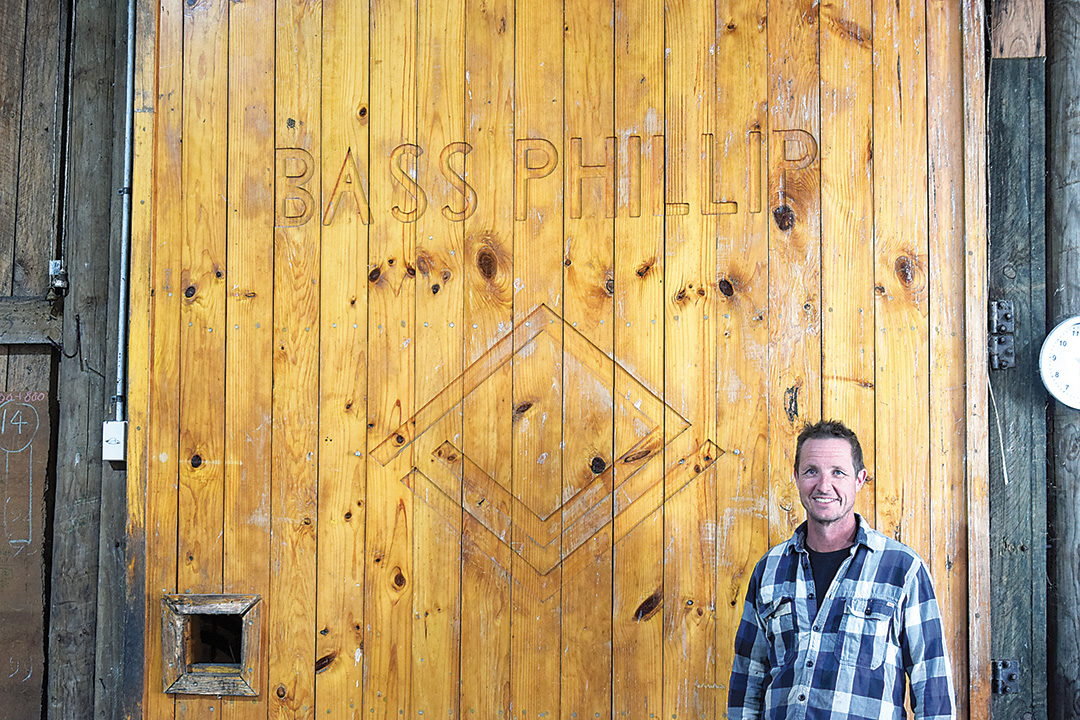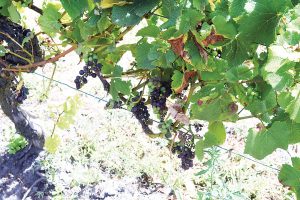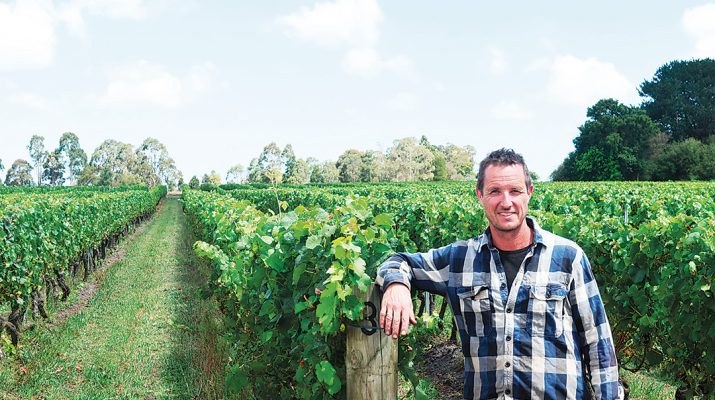Tom HAYES
AT the end of 2024, the tasters at James Suckling compiled their official rankings for Australia’s top 100 wines of the year.
From the more than 2200 wines that were tested in a six-month period, two Gippsland wines ranked inside the top 100.
James Suckling tasters ranked the wines based off a number of criteria, including basis of quality, availability, price, and ‘wow’ factor.
The first local wine to make the top 100 list was Bass Phillip’s Pinot Noir Gippsland Premium 2022, from Leongatha South, which ranked number 44 with a score of 97.
The tasting notes from James Suckling stated: “Pure and sophisticated aromas of dark cherries, raspberries, cassia bark, and we earth. The palate is medium-bodied with finely integrated tannins and bright acidity, giving notes of blackberries, tobacco leaves, and graphite. Very tightly wound and focused. Opens up in the glass and shows its purity.”
The first Bass Phillip vines were planted in 1979 by the first owner, Phillip Jones, from whom the current owners bought the business, believed to be the first vines planted in South Gippsland.
Gippsland Farmer spoke to Bass Phillip General Manager, Adam Francis, after the Pinot Noir’s inclusion into the top 100 ranking.
Mr Francis moved to Adelaide in the early 2000s, after growing up and spending his early years in Suffolk (east coast of the United Kingdom).
Following a successful career in construction, Mr Francis, his wife and two daughters moved to regional Victoria to take over the reins at Bass Phillip from 2020.
“My brother-in-law is a winemaker in France, in Burgundy, he did some consulting with Phil (Mr Jones) back in the early 2000s,” Mr Francis said.
“They heard that this was coming up for sale, wanted a Burgundy winemaker to associate their name with this, so he (Mr Jones) asked his people in France, and they put him onto my brother-in-law.
“And he (Jean-Marie Fourrier) in turn got in touch with myself and my wife and said, ‘How would we feel about running a winery in Victoria?’”
Mr Francis told Gippsland Farmer that he always had an interest in wine and winemaking. Growing up in the UK, he had family friends who were wine importers, which exposed him to the industry.
When Mr Francis’ sister married a Frenchman, and he got the chance to travel to France in the late 1990s and early 2000s, which opened the door for him to get his first experience in winemaking and harvesting.
Gippsland wines among nation’s best

WHILE living in Adelaide as a carpenter, Mr Francis’ hobby was to make beer with a friend, which allowed him to get familiar with fermentation processes, so when the opportunity arose at Bass Phillip, he thought he’d “be mad to say no”.
Mr Francis admitted that he had no idea what he was getting into when he first got started in Leongatha South.
“I hadn’t seen a growing season. I’d seen a few harvests and the processing of grapes into wine. But as for the year-round experience, I was in the deep end,” he said.
Following the purchase of the winery in 2020, the COVID-19 pandemic hit the world, and with that came a number of complications for Bass Phillip.
“Initially, the plan was for my brother-in-law to come over (from France) several times a year to advise, and help, and guide us through the whole process. But obviously a travel ban stopped all that,” he said.
Instead, the team had to connect from the other side of the world through Zoom calls, which made things difficult, according to Mr Francis.
Plenty of help was still on deck, however. The vineyard manager, Mick Kelly, who was managing their other Leongatha vineyard at the time, was able to assist with the site at Leongatha South.
Despite admitting that Bass Phillip’s mention on James Suckling’s top 100 ranking had “slipped through the radar”, Mr Francis said: “It’s always been well-regarded, it’s widely respected as one of the best pinot producers in Australia.”
“In 2008 I think, our reserve wine got the number one wine in Australia from Halliday (Wine Companion), that’s what I think really put it on the map,” he said.
“And since then, we’ve been really lucky, we’ve always scored pretty highly with the critics and consumers alike.
“It’s always nice to get recognised by critics, journalists. It’s been on a pedestal for quite a number of years now, and it typically scores well and has a strong reputation.
“We’re continually looking to improve, and the scope to do that is tangible.”
Without knowing what the critics are looking for, Mr Francis admitted that Bass Phillip lets the season do the talking, allowing the wine to be a reflection of the season.
“Pinot and chardonnay, which is what we’re known for, they’re a wine of place more so than something that the winemaker does,” he said.
“It’s not our winery that makes the wine, it’s what happens through the year, the growing season out in the vineyard, which is really where the wines are made.
“I think what makes our wine special is where it’s grown, not what we do to the grapes.”
The Leongatha South vineyard, where the first Bass Phillip vines were planted, has about 2.7 hectares of vines. Most of the vines are pinot, with about a dozen rows for chardonnay and about half a row used for gamay, a purple-coloured grape that produced a light-bodies red wine.
Bass Phillip also use grapes from the other Leongatha vineyard, which is massive in comparison – about eight hectares. They will have access to more grapes soon, with the opening of a 3.6 hectare vineyard at Kardella (between Leongatha and Korumburra).
“While it’s not state-of-the-art, it’s more fit for purpose,” Mr Francis said of the Kardella vineyard.
The Leongatha South vineyard yields roughly six to 10 tonnes of grapes, included in the total harvest from all three vineyards adding up to be 30-60 tonnes.
All up, Bass Phillip produces anywhere from 28,000 to 58,000 bottles of pinot noir, 3000 to 6000 bottles of chardonnay, 600 to 1200 bottles of gamay, and 200 to 500 bottles of gewurztraminer.
With strong domestic sales, Bass Phillip also has a strong export market, especially in Asia, as well as Europe, the UK, and the US.
ALSO making the list was Yarragon’s William Downie Pinot Noir Gippsland Bull Swamp 2023, ranked at number 80, with a score of 95.
The James Sucking tasting notes stated: “This is the most Burgundian pinot noir of a brilliant suite, sourced from a lower, more humid site in Gippsland. A sinuous, denser feel with an elegant, medium-bodied framework. Root spices, shiitake mushrooms, dashi, exotic brown spices and a dark veil of fruit allusions lain across woodsy tannins. Delicious. From biodynamically grown grapes. Drink or hold.”
Gippsland Farmer also got the chance to speak to William Downie himself, on his history in the industry and what he aims to do when making pinot noir.
“It’s good for Gippsland and that matters a great deal because there aren’t many (from the region) when you travel outside of Australia,” Mr Downie said.
“People (outside of Australia) know the Barossa Valley, maybe they’ve heard of the Yarra Valley, and until quite recently they didn’t have a clue that Gippsland really existed, but that is starting to change.”

The William Downie winery itself is in Warragul, leasing what was the Wild Dog winery. William Downie also use a couple of hectares of vines from Yarragon, as well as various other locations across the region and on the outer, including Mornington Peninsula, to produce its pinot noir.
Mr Downie said his first job in the wine industry was in fact with Bass Phillip.
“I spent not quite two years there and then I left and went to work in the Yarra Valley for a bit over a year,” Mr Downie said.
Following his stint at the Yarra Valley, Mr Downie then went to work in Burgundy, France before making his own label in 2003 – which wasn’t always Gippsland based.
“Originally after we came back from Burgundy we were based in the Yarra Valley, and in fact the first ones we made were from the Yarra Valley,” he said.
“We bought our farm in 2006 and planted the first vines there in Yarragon in 2008, and we also started buying grapes from growers in 2008.”
Then, down the track in 2016, William Downie leased two more local vineyards to help with production.
It’s not the first time that a William Downie wine has made the James Suckling top 100 rankings.
“James Sucking has been to our place before, and a number of the reviewers have also been to our place,” he said.
Again, it appears as if local winemakers aren’t so much fussed with what the critics think but give more care to make the wine a truer reflection of the season just passed.
“We set the standard for ourselves, and we measure whether we met that standard or not, so we’re not particularly interested in what the experts have to say,” Mr Downie said.
“For us it’s really about trying to make wines that are a true reflection of the place and season as can be, and that isn’t always the best wine.
“There is often a difference between the best wine and the truest wine, and the experts tend to look for the best wines, and people who are really passionate about the wine tend to look for the truest ones.”
Mr Downie agreed that, due to the erratic weather in Gippsland, the region is a tough place to grow grapes.
“It’s all we’ve ever known really so it’s normal in a way. But it does have the impact in a sense that we’ve had a long run of poor flowering due to inclement weather, and that reduces yields quite a lot,” he said.
“Each season is a bit different and some of them are wetter and cooler and some are warmer and drier, but there is not necessarily, in my mind, a qualitative difference between a warm seasoning and a wet one.
“They all have difference characters, and you can still have wine that has depth and structure and aromatics.”
THE number one-ranked Australian wine for 2024 was a Stefano Lubiana Pinot Noir Tasmania La Roccia 2022.
Retailed for just $61 while scoring a 99, the James Suckling tasting notes read: “Sophisticated and pure, with lifted aromas of dark cherries, forest floor, wild raspberries, dried herbs, and orange peel.”
“The palate is medium-bodied with tightly wound acidity and finely integrated tannins giving notes of blackberries, potpourri, violets, and chalk. Exceptionally well-constructed, with a savoury edge from 100 per cent whole-cluster fermentation. A nearly perfect and complete Australian pinot noir. Brilliant. Drink or hold,” it continued.
Ranking second was Tyrell’s Shiraz Hunter Valley Old Patch 2023, which was the only other wine to score a 99.
A quarter of the wines on the top 100 list could be found priced under $40. Fifty of the wines on the list were reds, 45 were whites, along with two sparkling wines, one fortified wine, and one dessert.
Forty-one of the wines were from Victoria, 30 from South Australia. 16 from Western Australia. 10 from Tasmania (including the number one wine), and three from New South Wales.

